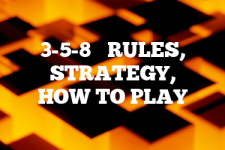Sedma: A Reference Guide to Rules, Winning Strategy & Play Instructions
Introduction
Sedma is a popular trick-taking game from Central Europe. Played with a 32-card deck, Sedma is a game of strategy and skill that can be enjoyed by two to four players.
Players and Cards: Sedma is typically played by two players, but can also be played with 3 or 4 players. It uses a subset of a standard 32-card Piquet deck, with the 7s and 8s of all suits removed for a total of 24 cards.

Objective: The main objective of the game is to win tricks, which are rounds where each player plays a card and the highest card takes the trick. The player who wins the most tricks wins the game.
Gameplay: The dealer distributes four cards to each player and then play begins. Each player plays a card in turn, with the highest card winning the trick. The player who wins the trick then leads the next trick. A special rule in Sedma is that a seven card can ‘capture’ the trick, regardless of what other card is played.
Scoring: The scoring in Sedma is based on the number of tricks won. Each trick is worth one point, and the player with the most points at the end of the game wins.
Special Rules: Sedma has a few unique rules that set it apart from other trick-taking games. For instance, if a player plays a seven, they automatically win the trick, regardless of what the other card is. This one rules opens up a lot of fun, in my experience, at least! Additionally, if a player has the seven and the over of the same suit, they can declare “Sedma” and win the trick automatically.
Quick Tip for Sedma
Remember, in Sedma, the aim is not just to win tricks but to win the right tricks. Always keep an eye on the cards your opponents are playing and adjust your strategy accordingly.
Rules for playing Sedma
The rules of Sedma are relatively straightforward. The game is played in a clockwise direction, with each player playing one card to each trick. The player who plays the highest card of the same suit as the lead card wins the trick. However, there are two exceptions to this rule: the 7 (which is the lowest card) can take a trick containing a King, and the 7 of Hearts (Sedma) can take any trick. Some players also introduce ‘house rules’ to add an extra layer of complexity to the game.
The Deal for Sedma
In Sedma, the dealer shuffles the deck and deals four cards to each player. The remaining cards are placed face down in the middle of the table to form the stock. The top card of the stock is turned face up to determine the trump suit.
How to Play Sedma
- Setup: The player to the dealer’s left leads the first trick.
- Gameplay: Players take turns playing a card, trying to win the trick by playing the highest card of the same suit or a 7.
- End of the Game: The game ends when all cards have been played. The player with the most tricks wins.
- Scoring: Each trick is worth one point. The player with the most points at the end of the game wins.
How to Win at Sedma
Winning at Sedma requires a good balance of strategy and luck. It’s important to keep track of the cards that have been played and to make the most of your 7s. Remember, the 7 of Hearts can take any trick, so use it wisely!
One key aspect of Sedma lies in keeping a keen eye on the cards that have been played. This is not a game where you can simply play your hand without considering the cards on the table. Remember, each card you play is a response to what has been played before and a setup for what will be played next. Observing the cards that have been played gives you an idea of what’s left, helping you calculate your moves and anticipate your opponents’.
In Sedma, the value of 7s, particularly the 7 of Hearts, is immense. The 7 of Hearts holds the power to take any trick, regardless of other cards in play. This gives it a unique strategic value. However, it’s crucial to use this card wisely. When you hold the 7 of Hearts, you essentially have a trump card that can significantly shift the game in your favor. But, deploying it at the right moment is the key. A poorly timed play can leave you vulnerable later in the game when you might need it most.
Considering these elements in your gameplay can significantly alter your performance in Sedma. It’s not merely about the cards you’re dealt, but how you play them. Remember, a good balance of strategy and luck can make the difference between winning and losing. So, always keep track of the played cards, make the most of your 7s, and use the 7 of Hearts judiciously to ensure a potential victory.
Sedma Strategy Tips
One of the best strategies in Sedma is to try and control the game by winning the right tricks. This means playing your high cards at the right time and saving your 7s for when you really need them. It’s also a good idea to keep track of what cards your opponents have played so you can anticipate their moves.
Playing your high cards at the right time is a strategy that can determine the course of the game. This doesn’t mean you should play your high cards at the onset of the game; instead, you need to be prudent about when to use them. Timing is everything. For example, using your high cards when your opponents have already played theirs can provide you with a significant advantage. This can help you win more tricks and control the game effectively.
Another crucial aspect of this strategy is saving your 7s for critical moments. In Sedma, the 7s are particularly valuable and can turn the tide of the game in your favor. Therefore, it’s essential to resist the temptation to play these cards early in the game and instead, save them for when you really need them. This could be when you’re losing and need to win a trick to reclaim the lead, or when you’re trying to win the last trick to secure the game.
Furthermore, keeping track of what cards your opponents have played can provide you with invaluable insights. By observing and remembering the cards that your opponents play, you can anticipate their moves and plan your strategies accordingly. This can help you predict what cards they are likely to play next, allowing you to counteract their moves effectively.
While this strategy doesn’t guarantee a win – as Sedma, like all card games, involves an element of luck – it can certainly increase your chances of success. It’s all about understanding the dynamics of the game, anticipating your opponents’ moves, and making smart decisions about when to play your high and low cards. So, whether you’re a novice or a seasoned player, implementing this strategy can significantly enhance your Sedma gameplay.
Variations of Sedma
There are several variations of Sedma, including versions for two, three, and four players. Some variations introduce additional rules, such as allowing the 7 of Hearts to be played at any time, or changing the value of certain cards.
Scenarios
There are many different scenarios that can arise in a game of Sedma. For example, you might find yourself with a hand full of low cards, or you might be in a position where you need to win every remaining trick to win the game. In these situations, it’s important to stay calm and think strategically about your next move.
Frequently Asked Questions
- What happens if two players play a 7 in the same trick? The first 7 played wins the trick.
- Can I play the 7 of Hearts at any time? In the standard rules, the 7 of Hearts can only be played if you have no other cards of the same suit. However, some variations allow it to be played at any time.
- What is the best strategy for winning at Sedma? The best strategy is to keep track of the cards that have been played and to make the most of your 7s.
External Links
Given the special 7 rule in Sedma, not surprising that the game’s name translates as ‘the seventh’

A digital native around since the early days of online gaming communities around 2001. An early contributor to the cult gaming site ClanTemplates, Adam has spent years giving free gaming resources to the community. With BoardCards, Adam is most experienced and commonly writing the articles on Strategy multi-player games like Settlers of Catan and Avalon. His first introduction to board games was via Mancala, an Egyptian-origin stone game and one of the oldest known games still played worldwide. Contact me via email



